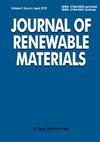Remediation of Cu Contaminated Soil by Fe78Si9B13AP Permeability Reaction Barrier Combined with Electrokinetic Method
4区 材料科学
Q2 Environmental Science
引用次数: 1
Abstract
Iron-based amorphous crystalline powder Fe 78 Si 9 B 13AP is used as a permeability reaction barrier (PRB) combined with an electrokinetic method (EK-PRB) to study the removal rate of Cu in contaminated soil. After treating Cu-contaminated soil for 5 days under different voltage gradients and soil water content, the soil pH is between 3.1 and 7.2. The increase of voltage gradient and soil water content can effectively promote the movement of Cu 2+ to the cathode. The voltage gradient is 3 V/cm, and the water content of 40% is considered to be an optional experimental condition. Therefore, under this condition, the effects of Fe 78 Si 9 B 13AP and zero-valent iron (ZVI) as PRB on the removal rate of total Cu in soil and the transformation of chemical forms of Cu are studied. Compared with ZVI, Fe 78 Si 9 B 13AP as PRB has a better remediation effect. EK-Fe 78 Si 9 B 13AP can remove 80.3% of total Cu in soil, and the biologically available Cu is reduced to 3.6%, which effectively reduces the environmental risk of contaminated soil.Fe78Si9B13AP渗透反应屏障联合电动力学法修复铜污染土壤
本文章由计算机程序翻译,如有差异,请以英文原文为准。
求助全文
约1分钟内获得全文
求助全文
来源期刊

Journal of Renewable Materials
Materials Science, Composites; Polymer Science; Green & Sustainable Science & Technology-
CiteScore
4.10
自引率
0.00%
发文量
125
期刊介绍:
This journal publishes high quality peer reviewed original research and review articles on macromolecules and additives obtained from renewable/biobased resources. Utilizing a multidisciplinary approach, JRM introduces cutting-edge research on biobased monomers, polymers, additives (both organic and inorganic), their blends and composites. JRM showcases both fundamental aspects and applications of renewable materials. The fundamental topics include the synthesis and polymerization of biobased monomers and macromonomers, the chemical modification of natural polymers, as well as the characterization, structure-property relationships, processing, recycling, bio and environmental degradation and life cycle analysis of the ensuing materials, in view of their potential applications. Within this sustainability approach, green chemistry processes and studies falling within biorefinery contexts are strongly favored.
 求助内容:
求助内容: 应助结果提醒方式:
应助结果提醒方式:


